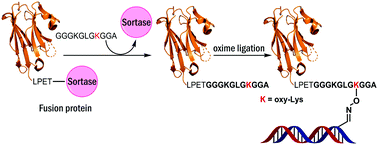当前位置:
X-MOL 学术
›
Chem. Commun.
›
论文详情
Our official English website, www.x-mol.net, welcomes your feedback! (Note: you will need to create a separate account there.)
Site-specific cross-linking of proteins to DNA via a new bioorthogonal approach employing oxime ligation†
Chemical Communications ( IF 4.9 ) Pub Date : 2018-05-24 00:00:00 , DOI: 10.1039/c8cc01300d Suresh S. Pujari 1, 2, 3, 4, 5 , Yi Zhang 3, 4, 6, 7 , Shaofei Ji 3, 4, 5, 6, 7 , Mark D. Distefano 3, 4, 6, 7 , Natalia Y. Tretyakova 1, 2, 3, 4, 5
Chemical Communications ( IF 4.9 ) Pub Date : 2018-05-24 00:00:00 , DOI: 10.1039/c8cc01300d Suresh S. Pujari 1, 2, 3, 4, 5 , Yi Zhang 3, 4, 6, 7 , Shaofei Ji 3, 4, 5, 6, 7 , Mark D. Distefano 3, 4, 6, 7 , Natalia Y. Tretyakova 1, 2, 3, 4, 5
Affiliation

|
DNA–protein cross-links (DPCs) are super-bulky DNA adducts induced by common chemotherapeutic agents, reactive oxygen species, and aldehydes, and also formed endogenously as part of epigenetic regulation. Despite their presence in most cells and tissues, the biological effects of DPCs are poorly understood due to the difficulty of constructing site-specific DNA–protein conjugates. In the present work, a new approach of conjugating proteins to DNA using oxime ligation was used to generate model DPCs structurally analogous to lesions formed in cells. In our approach, proteins and peptides containing an unnatural oxy-Lys amino acid were cross-linked to DNA strands functionalized with 5-formyl-dC or 7-(2-oxoethyl)-7-deaza-dG residues using oxime ligation. The conjugation reaction was site-specific with respect to both protein and DNA, provided excellent reaction yields, and formed stable DPCs amenable to biological evaluation.
中文翻译:

通过采用肟连接的新型生物正交方法 ,蛋白质与DNA的位点特异性交联†
DNA-蛋白质交联(DPC)是由常见的化学治疗剂,活性氧和醛诱导的超大体积DNA加合物,并且作为表观遗传调控的一部分在内部形成。尽管在大多数细胞和组织中都存在DPC,但由于难以构建位点特异性的DNA-蛋白质结合物,人们对DPC的生物学作用了解甚少。在目前的工作中,一种使用肟连接将蛋白质与DNA结合的新方法被用于生成结构上类似于细胞中形成的损伤的模型DPC。在我们的方法中,使用肟连接将包含非天然oxy-Lys氨基酸的蛋白质和肽交联到用5-甲酰基-dC或7-(2-氧代乙基)-7-脱氮基-dG残基官能化的DNA链上。结合反应对于蛋白质和DNA都是位点特异性的,
更新日期:2018-05-24
中文翻译:

通过采用肟连接的新型生物正交方法 ,蛋白质与DNA的位点特异性交联†
DNA-蛋白质交联(DPC)是由常见的化学治疗剂,活性氧和醛诱导的超大体积DNA加合物,并且作为表观遗传调控的一部分在内部形成。尽管在大多数细胞和组织中都存在DPC,但由于难以构建位点特异性的DNA-蛋白质结合物,人们对DPC的生物学作用了解甚少。在目前的工作中,一种使用肟连接将蛋白质与DNA结合的新方法被用于生成结构上类似于细胞中形成的损伤的模型DPC。在我们的方法中,使用肟连接将包含非天然oxy-Lys氨基酸的蛋白质和肽交联到用5-甲酰基-dC或7-(2-氧代乙基)-7-脱氮基-dG残基官能化的DNA链上。结合反应对于蛋白质和DNA都是位点特异性的,



























 京公网安备 11010802027423号
京公网安备 11010802027423号